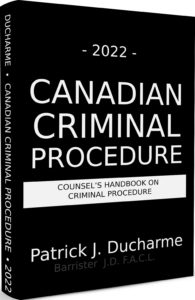In every criminal trial the accused is presumed innocent and remains innocent until proven guilty beyond a reasonable doubt. Every alleged crime can be defined by its specific elements. Each essential element of a crime must be proven beyond a reasonable doubt. Except in rare instances, it is generally the prosecutor’s obligation to prove each essential element of a crime beyond a reasonable doubt to secure a conviction. Failure to do so will result in an acquittal. The formal finding of an acquittal is a verdict of “not guilty.”
In every case the prosecutor must prove at least three things:
1. That an act or series of acts have been committed that amount to the commission of a crime(s), known in Latin as the actus reus or the prohibited act of a crime.
2. That the act or series of acts was, or were, intended, known in Latin as the mens rea or the intentional part of the crime; and,
3. That the accused person committed the crime, or, the element of “identity.”
In trials of the more serious crimes the accused will usually defend himself with the assistance of a lawyer. The lawyer representing an accused person is referred to as the Defence lawyer or Defence counsel. Virtually all crimes in Canada require proof beyond a reasonable doubt of guilt for conviction. There are many specific offences identified in the Criminal Code of Canada (“the Code”) and other statutes such as the Controlled Drugs and Substances Act (‘the CDSA”).
There are many defences that are available to an accused in Canada and most are identifiable by a very specific name. Some examples are: duress, necessity, alibi, consent, self defence, not criminally responsible on account of mental disorder, and accident. The accused is not required to specify a particular defence in advance of the evidence presented by the prosecutor.
Certain defences, however, such as the defence of alibi, should be disclosed in advance of the trial because failure to disclose an alibi defence to the prosecutor in advance may cause the court to draw an adverse inference in favour of the prosecution. The rationale for this insistence on prior disclosure is that the prosecutor should be given an adequate opportunity to investigate the alibi before trial and be able to challenge it with evidence of its own demonstrating weaknesses in the alibi defence at trial.
Using alibi as an example, if the defence advises the prosecutor in advance of the trial that an alibi defence will be advanced at trial, and, provides the prosecutor with the anticipated evidence of alibi witnesses, and also provides the prosecutor a fair opportunity to test the alibi before the evidence is actually presented, the court is unlikely to draw any adverse inference against the alibi defence. A fair opportunity generally refers to providing the prosecutor with the names and contact information of the intended alibi witnesses.
If the alibi evidence remains reliable even after the prosecutor has been provided with a fair opportunity to examine and challenge it carefully, the court will not draw any adverse inference against the accused, or more specifically, against the evidence of alibi. But the defence of alibi is somewhat unique in this regard. It is unlike most other defences where no adverse inferences may be drawn from the fact that the accused or his counsel do not alert or advise the prosecutor or the court in advance of the evidence to be presented on behalf of the defence.
All available defences exist within the narrow confines of the three fundamental points below. That is, every defence counsel assisting an accused person at trial will be attempting to demonstrate one or all the following:
1. That the prohibited act or crime alleged did not occur.
2. If the prohibited act or crime alleged did occur that the accused did not commit it; or,
3. If the prohibited act or crime alleged did occur and the accused did physically commit the act, that the accused did not intend to commit the act.
The accused is always entitled to advance the ultimate challenge to the prosecution:
i. the act that you allege did not occur.
ii. if it did occur, I did not cause or commit it; and,
iii. if it did occur, and I did cause or commit the act alleged, then I did not intend to do it and therefore I should be acquitted because the intention to commit the offence is an element of the offence that the prosecution must prove beyond a reasonable doubt and has failed to do so.
Any or all these defences, if accepted by the court, could lead to a finding of not guilty, referred to in Canada as an acquittal. When one is acquitted of the crime the court has found that the accused is not guilty, either because the Crown did not prove what it needed to prove to convict, or, the accused established a valid defence. Proof of guilt is at the highest level, referred to as proof of guilt beyond a reasonable doubt.
Defining the term “reasonable doubt” requires a trial Judge to instruct himself or a jury that the standard of proof ‘beyond a reasonable doubt’ is inextricably intertwined with that principle fundamental to all criminal trials, the presumption of innocence. The burden of proving something beyond a reasonable doubt rests on the prosecution throughout the trial. It never shifts to the accused.
Reasonable doubt can be defined by what it is not. A reasonable doubt is not a doubt based upon sympathy or prejudice. Instead, a reasonable doubt is based upon reason and common sense. Reasonable doubts should be logically connected to the evidence or absence of evidence. It does not require proof to an absolute certainty. It does, however, require proof that the accused is more than just “probably guilty.” A jury that concludes that the accused is only probably guilty must find the accused not guilty.1

The above is the an excerpt of Patrick J Ducharme’s book, Canadian Criminal Procedure, available at Amazon or in bulk through MedicaLegal Publishing along with Criminal Trial Strategies.
Subscribe to Patrick Ducharme’s Youtube Channel.
